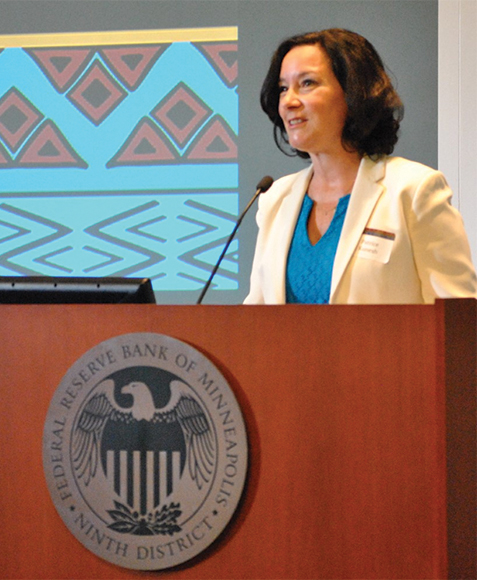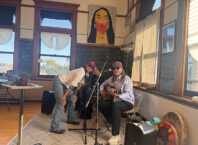
By Lee Egerstrom
At the mention of the word infrastructure, most people think of roads, bridges, airports and other physical structures that support commerce and industry. Patrice Kunesh thinks of people.
Kunesh (who is of Standing Rock Lakota descent) is a vice president of the Federal Reserve Bank of Minneapolis, simply referred to as the Minneapolis Fed. She is also director of the Fed’s one-of-a-kind Center for Indian Country Development housed at the bank.
Now in its fourth year, the Center brings people together to research and share information that can help American Indian communities throughout the nation succeed, grow and prosper. It all starts with people, Kunesh insists.
“People think the Federal Reserve (System) has just two goals: low inflation, high employment. It does, but that’s not all,” she said. Finding ways to achieve those goals, especially in often remote areas of Indian Country, requires a people-oriented approach, she added.
The first conference hosted by the Center was on early childhood development for the Indian communities. The second major conference was on home ownership and mortgage lending. A conference for this fall is being planned on agriculture in Indian Country.
The research center often partners with other groups for information sharing conferences and to publish research that tribes and local governments, as well as individuals, might use.
Among featured materials on the Center’s website is a report on a May conference, “Shaping the Future of Indigenous Early Learning: A Visioning Workshop for Investors.” Another is research by Richard Todd, a recently retired Minneapolis Fed vice president, entitled “The Availability of Local Jobs Varies Widely among American Indian Reservations.”
Kunesh has two recent columns on the site, “Op-Ed: Getting Real about Indian Country – Surprising Progress in the Heartland” and a springtime review of what the Center has been doing, “Note from the Director – Springing Forward.”
People friendly resources from the Center are online maps showing Native American Financial Institutions that are mostly banks and credit unions. Another is a downloadable Tribal Leaders Handbook on Homeownership. This reflected a partnership approach. The Handbook contains forwards by the National Congress of American Indians, National American Indian Housing Council, Hawaiian Community Assets and Enterprise Community Assets.
Just as Twin Cities metro area people were reminded by homeless encampments this past winter, Indian Country has severe housing crises. There are many reasons, Kunesh said. Lack of access to financial institutions and tribal sovereignty rights on land ownership are among them.
None of these are barriers in themselves, she said. “Time is money. Some banks don’t bother if it takes more time to work out mortgage loans.” But, she said, government programs are available and there are ways to work out home loans.
All efforts to spur the economy and improve lifestyles in Indian Country become interwoven with the Center’s research. People are the focus. Tribal enterprises across the country employ more than 700,000 people, she said, making the tribes collectively among the largest U.S. employers.
That is a base to build on, she said.
The Center was started in 2015 by Minneapolis Fed President Narayana Kocherlakota. He left later that year to become a professor of economics at the University of Rochester.
In announcing the formation, Kocherlakota said, “This reflects our intent that the Center provide energy and coordination to Indian Country development initiatives across the Federal Reserve System and take a lead role in forging Federal Reserve partnerships with other national and regional organizations.”
Kunesh said the Center functions as originally intended. While housed and staffed by the Minneapolis Fed, it does work as the “unique, and only Indian development center for the entire Federal Reserve System.”
One reason for this is the shape of the Ninth Federal Reserve District. Its territory stretches from the Upper Peninsula of Michigan and 26 counties in Northwestern Wisconsin and includes all of Minnesota, the two Dakotas and Montana.
There are 45 federally recognized tribes and sovereign nations in the region and more diverse Native populations scattered throughout. Five recognized tribes are in the UP although there are 10 in Michigan. Minnesota and Wisconsin each have 11, nine are in South Dakota, seven in Montana, and there are five federally recognized reservations in North Dakota that are home to nine tribal groups.
This likely gives American Indians greater visibility in the Ninth District than in most of the Fed System’s 11 other districts, Kunesh said.
Kocherlakota, meanwhile, was succeeded at the Minneapolis Fed in 2016 by Neel Kashkari, a former space engineer who, after shifting to positions in finance, served as Assistant Secretary of the Treasury prior to joining the Fed. Consistent with objectives of the Center, Kashkari started a separate research entity, the Opportunity and Inclusive Growth Institute, which brings in visiting scholars to collaborate on projects.
The Center currently has four full-time researchers and administrative staff.
Kunesh has a law degree from the University of Colorado and a Master of Public Administration degree from Harvard. She represented American Indian tribes and worked for the Native American Rights Fund in her earlier law practice.
She has also served on the faculty of the University of South Dakota School of Law, was Deputy Under Secretary for Rural Development for the U. S. Department of Agriculture and the Deputy Solicitor for Indian Affairs at the Department of Interior before joining the Fed.
Donna Feir, a Canadian with a Ph.D. from the Vancouver School of Economics at the University of British Columbia, is the Center’s research economist. She is also a research fellow at the IZA Institute of Labor Economics, an international research group based in Bonn, Germany; and she is a member of a newly-formed Association for Economics Research of Indigenous People.
In her work as an applied labor economist and economic historian, Feir has published work on Indigenous labor market experiences, reconciliation, health and the impact of historic policies on Indigenous economies and people.
Jessie Welton is project manager and handles operations, communications and outreach efforts for the Center. She transferred from another department at the Minneapolis Fed in 2017, has a B.S. in economics from the University of Wisconsin-La Crosse and a Master of Public Policy from the University of St. Thomas.
The newest full-time member of the Center is Jim Colombe, from the Rosebud Reservation in South Dakota. After acquiring science degrees from Harvard University and Massachusetts Institute of Technology, Colombe has gravitated back to Indian Country.
“I really wanted to do something for my people,” he said.
For information about the Center for Indian Country Development and the Federal Reserve Bank of Minneapolis, see www.minneapolisfed.org/indiancountry and www.minneapolisfed.org.






